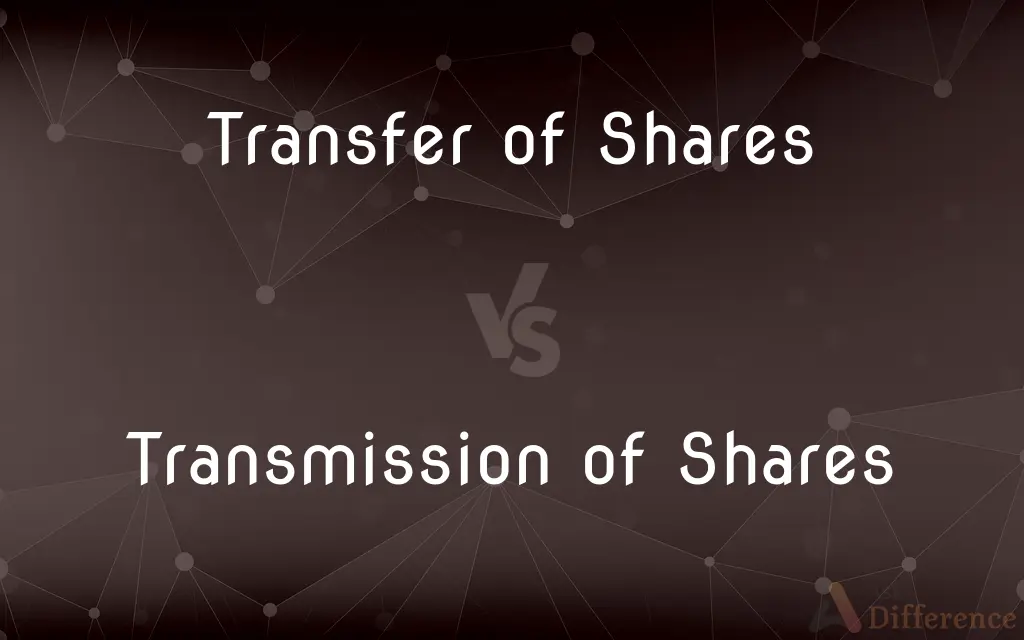Transfer of Shares vs. Transmission of Shares — What's the Difference?
By Tayyaba Rehman — Published on December 20, 2023
Transfer of Shares involves a voluntary act of a shareholder; Transmission of Shares is due to legal reasons like death or insolvency.

Difference Between Transfer of Shares and Transmission of Shares
Table of Contents
ADVERTISEMENT
Key Differences
Transfer of Shares refers to the voluntary act of a shareholder selling or giving their shares to another person. This action is initiated by the shareholder's desire, and typically involves a change in the ownership of the shares from one person to another.
On the contrary, Transmission of Shares happens due to legal reasons, such as the death, insolvency, or insanity of a shareholder. Unlike Transfer of Shares, Transmission of Shares is not a result of the shareholder's wish but a consequence of certain unavoidable circumstances.
In Transfer of Shares, documents like share transfer forms are vital, but in Transmission of Shares, legal proofs such as death certificates or court orders become crucial.
Both processes, however, result in a change in the ownership of shares but are initiated by different circumstances and reasons.
Comparison Chart
Nature
Voluntary act by shareholder.
Due to legal reasons like death or insolvency.
ADVERTISEMENT
Initiation
Shareholder's desire.
Unavoidable circumstances.
Documentation
Share transfer forms.
Death certificates, court orders.
Ownership Change
From one person to another.
To legal heirs or representatives.
Reason
Sale, gift, or other voluntary actions.
Death, insolvency, insanity.
Compare with Definitions
Transfer of Shares
An act initiated by a shareholder to change share ownership.
The Transfer of Shares process was initiated after both parties agreed on a price.
Transmission of Shares
Occurs when shares are passed to legal representatives.
Post the tragic accident, the Transmission of Shares process was initiated.
Transfer of Shares
Voluntary sale or gift of shares by a shareholder.
He made a Transfer of Shares to his daughter on her 18th birthday.
Transmission of Shares
Change in share ownership due to legal events.
After the shareholder's sudden demise, the Transmission of Shares to his heirs began.
Transfer of Shares
A transaction where a shareholder willingly relinquishes ownership.
The Transfer of Shares was completed after the documentation was verified.
Transmission of Shares
Result of events beyond the shareholder's control.
The Transmission of Shares was complicated due to multiple legal heirs.
Transfer of Shares
Change in share ownership due to intentional actions.
The company saw numerous Transfer of Shares after the buyback announcement.
Transmission of Shares
Enforced change in share ownership without shareholder's intention.
Insolvency led to the sudden Transmission of Shares to creditors.
Transfer of Shares
Result of a shareholder's decision to sell or gift shares.
The recent Transfer of Shares led to a shift in the company's board dynamics.
Transmission of Shares
Transfer of share ownership due to unavoidable circumstances.
The Transmission of Shares was mandated after the shareholder's declared bankruptcy.
Common Curiosities
What initiates a Transfer of Shares?
A Transfer of Shares is initiated by a shareholder's voluntary decision, such as selling or gifting the shares.
Can a shareholder refuse the Transmission of Shares?
No, Transmission of Shares is due to unavoidable legal circumstances and is not based on a shareholder's choice.
What documentation is needed for Transfer of Shares?
Transfer of Shares requires documents like share transfer forms and often, a sale agreement.
What's the primary difference between Transfer and Transmission of Shares?
Transfer of Shares is voluntary, while Transmission of Shares is due to legal events beyond a shareholder's control.
Why does Transmission of Shares occur?
Transmission of Shares occurs due to legal reasons like death, insolvency, or insanity of a shareholder.
Can Transmission of Shares be avoided?
No, it's a result of legal events like death or insolvency and cannot be avoided.
Who benefits from the Transmission of Shares?
Legal heirs or representatives usually benefit from the Transmission of Shares.
Can Transfer of Shares be reversed?
Once completed and registered, reversing a Transfer of Shares would require another transfer process.
Is there a fee for Transfer or Transmission of Shares?
There might be administrative or legal fees, but they vary depending on company policies and legal jurisdictions.
Can a company refuse a Transfer of Shares?
Depending on the company's articles of association and relevant laws, there may be conditions under which a transfer can be refused.
Who oversees the Transmission of Shares?
The process is overseen by legal entities and is usually subject to specific regulations and company bylaws.
Do both processes affect the total number of shares of a company?
No, both Transfer and Transmission change ownership, not the total number of shares.
How are shareholders informed of a Transmission of Shares?
Typically, the company is notified by legal representatives or heirs, who then make the necessary changes in the shareholder register.
How long does the Transmission of Shares take?
The duration varies based on legal procedures, documentation availability, and company processes.
Can a shareholder choose to either Transfer or Transmit shares?
No, Transfer of Shares is a choice, but Transmission of Shares is not optional and is due to legal circumstances.
Share Your Discovery

Previous Comparison
Civil Liability vs. Criminal Liability
Next Comparison
Cricket World Cup vs. Champions TrophyAuthor Spotlight
Written by
Tayyaba RehmanTayyaba Rehman is a distinguished writer, currently serving as a primary contributor to askdifference.com. As a researcher in semantics and etymology, Tayyaba's passion for the complexity of languages and their distinctions has found a perfect home on the platform. Tayyaba delves into the intricacies of language, distinguishing between commonly confused words and phrases, thereby providing clarity for readers worldwide.
















































